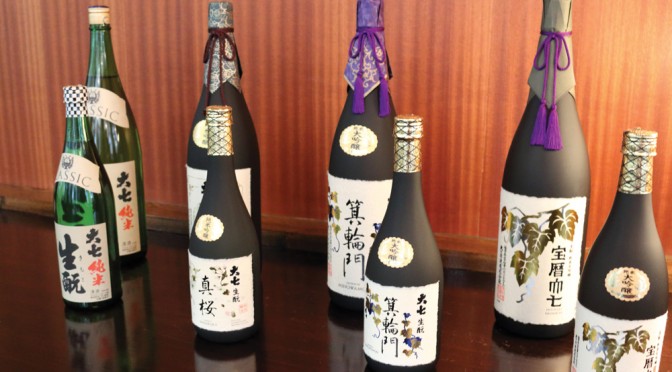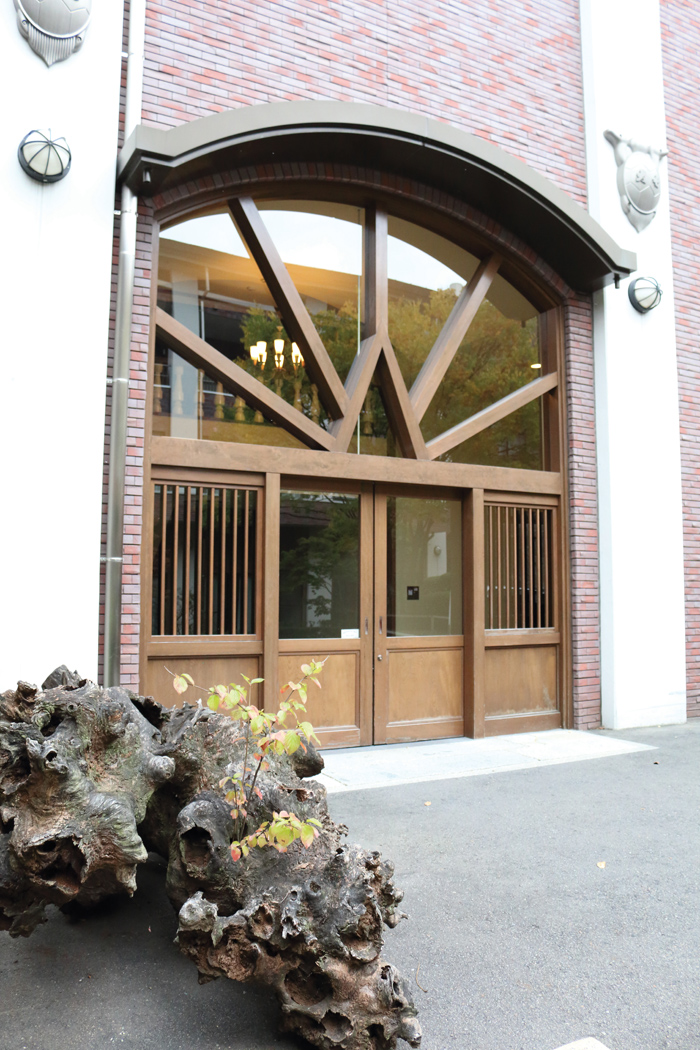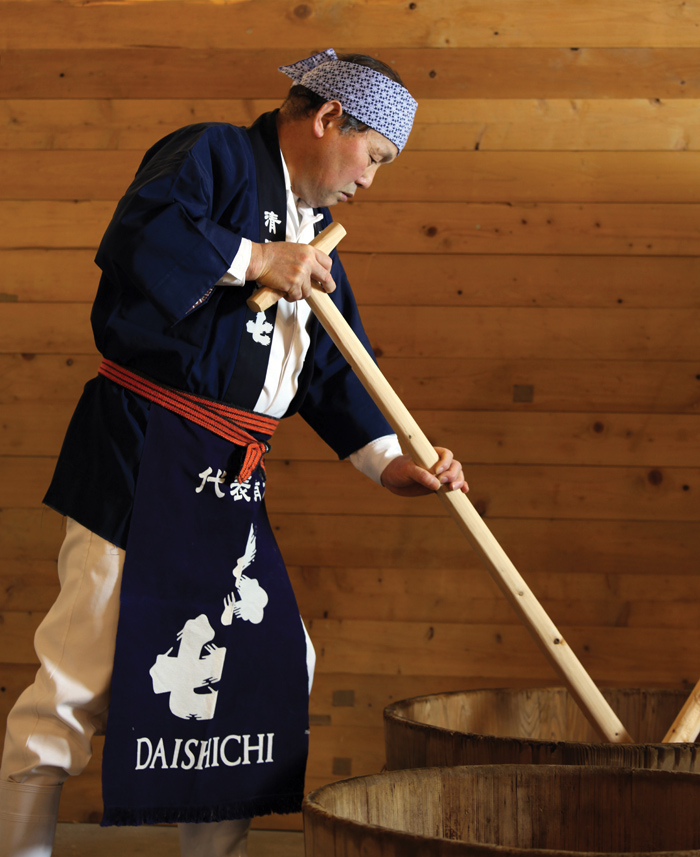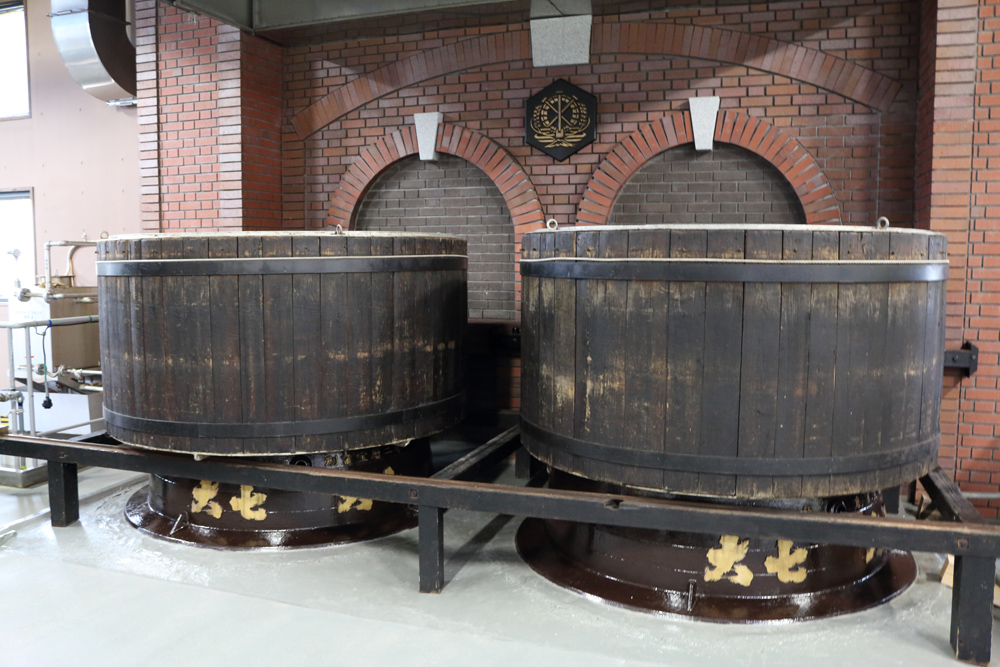Daishichi’s increasingly global fame owes to its ability to accommodate opposites: new technology with traditional techniques, modern marketing with older industry practices, and contemporary flavor trends with ancient styles. The brewery’s success is also tied to its 10th generation owner, Ohta Hideharu, a man who brings to social interactions all the refined formalities you’d expect from the equivalent of sake royalty, but who brims with an endearing, child-like excitement beneath it all. Ask about his brewery and that excitement spills over into giddy explanations of the many aspects of Daishichi that make it extraordinary. It’s clear he wants your average sake consumer to love his brand as much as diplomats and celebrity chefs.
Daishichi’s brewery is now housed in a modern, multi-story building Ohta had constructed around the old, creaky wooden one a few years ago. It towers massively over the other buildings in its neighborhood of Nihonmatsu. This provincial city in Fukushima where fewer than 60,000 people live lies primarily in the Abukuma River valley. Villages beyond the ridges, facing dwindling populations common to most rural areas in Japan, were annexed over a decade ago. Beyond sake, the city is also known for furniture manufacturing. With a train line running through it and resources obviously devoted to beautifying stretches along the lazy river, Nihonmatsu is by no means a backwater town. A brewery of Daishichi’s sophistication, though, is certainly an outlier.
People may pine with nostalgia for the older, classical brewery building. Ohta left the layout of the key brewery components as is, to protect the microbial ecosystem so essential to the character of their sake. The older brewery, however, wasn’t feasible for Daishichi’s continued operations. Nor was it particularly safe in a region known for earthquakes. The new building is striking for its Western-style architecture, complete with dormer windows and a high-ceilinged lobby reminiscent of old European hotels. Paintings and sculptures adorn walls and ledges in much of the building, and there is even stained glass. In contrast to all the modern sheen, what Daishichi does in the brewery itself is definitively Old School. No brewery in Japan has been more devoted to brewing in the kimoto style, the techniques of which were nearly lost to obscurity in the 20th century.
After showing me a slickly produced information video about the brewery in an elegant conference room, Ohta is eager to give an actual tour of the brewery. On our way to the main rooms for brewing–the building is cavernous and takes time to navigate–we talk about his ancestors. One of his forebears, Ohta Saburoemon Yoshishige, established the brewery in 1752 at the age of 32, himself a descendent of merchant-brewers who had settled the area over 100 years previously. Relative fame came to them with the 8th generation head of the family–Ohta Shichiemon Sadaichi, the current owner’s grandfather–who won the top prize at the Fukushima sake contest in 1927, and then the top prize at the national competition of that period in 1938. With national recognition, he decided to change the brewery’s brand name from “Big Mountain” to “Big Seven” (Daishichi), which incorporated “dai” from the previous name and the “shichi” from his middle name. The Shichiemon name had been passed down through the owners since the 3rd generation, all the way to his son–Hideharu’s father. With the weight of such history on the current Ohta Hideharu’s shoulders, perhaps it’s no surprise that he has stuck with their time-tested method of brewing in the kimoto style.
The technique that defines the sake as kimoto transpires in a room that is anything but modern. A row of over-sized pails stretches across the middle of the floor. Here, Daishichi’s brewers, led by toji Sato Takanobu, use poles to mash the yeast starter into a porridge-like substance while natural lactic acid bacteria from the environment falls in. Larger stainless-steel vats line the edge of the room, containing yeast starter that has advanced beyond the initial stage where the poles are used.
The pole-mashing process makes this style of brewing quite labor intensive. And instead of the typical fourteen days required to make starter using the more modern sokujo method, where brewers add liquid lactic acid at the beginning, Daishichi’s kimoto starter requires thirty days before being ready. Not compromising technique in the interest of time, as we will see, is a creed that informs every aspect of Daishichi’s brewing Ohta claims there are several benefits to the kimoto method. The starter has a higher purity of yeast because the process enables the lactic acid to linger and prevent any wild yeast from entering the mixture. While not critical to every brewer, Ohta is perhaps more concerned with this because Daishichi typically uses proprietary yeast found in no other brewery, cropping it from the foam during fermentation for reuse. Cultivating yeast, rather than buying it to pitch each brewing season, requires time and effort. The yeast, however, is one of the many things that lends Daishichi’s sake distinct character.
The kimoto method, according to Ohta, also results in a lower, but stronger, population of yeast. This in turn enables a long fermentation at lower temperature that the brewers, through other related adjustments in technique, are able to exploit for highly refined sake with complex flavor. Again, this takes extra time, but time is not an issue.
Even before reaching the starter phase, Daishichi’s employees have invested more time and physical labor in the brewing preparations than most breweries. It starts with the rice polishing, which is yet another remarkable story. Daishichi has pioneered the practical use of chohenpei seimai or “super-flat rice polishing.”
Sake brewers mill down the outside of rice grains to varying degrees. The point is to remove fats and proteins that can lead to less refined flavors. Brewers want the convertible starches at the core. Naturally, the more that you mill, the closer you get to isolating those starches, but the more time-consuming and expensive the whole operation becomes. That, at least, is the simplified version.
Now picture a grain of rice. It’s not exactly a sphere. Most milling techniques remove the outer portion of the rice in equal amounts across the surface, leaving thicker ‘deposits’, so to speak, on the longer axis. What if you could mill the rice in a way that enables you to remove more of the fats and proteins without also losing the valuable starches toward the core? A research professor actually discovered a way to make this work, though Daishichi implemented it and eventually produced better results on their aging milling machine. It proved more conducive to trial-and-error tweaking–another unexpected benefit of sticking to Old School.
The technique calls for dropping a smaller volume of rice than normal on a grinding stone, which is a common component of older milling machines. Daishichi has also determined that slowing the RPMs yields better results. The rice grains consequently spin on their long axis as they float down the edge of the spinning stone. Daishichi ends up with rice grains that have been polished less but also have less protein content. In the model Daishichi shares, Yamadanishiki rice of which 65% has been milled away in the traditional method measures 51% protein content. Daishichi can mill away half–which is still a relatively opulent amount in the sake world–and end up with only 44% protein remaining. This is, if you will take our word for it, revolutionary. Every brewery should be using it, right?
This difference in the rice can require some adjustments in the recipe and brewing process. Most competent brewers can adjust since rice changes from season to season. Most brewers, however, are not given the luxury of time that this method requires. The super-flat rice polishing method will take six days to reach 50%, which is anywhere from three to four times longer than the standard method. A handful of other breweries have shifted to this method, but the Director General of the Ministry of Science and Technology singled out Daishichi’s miller as a pioneer, bestowing him, instead of a toji, with a “Master Craftsman of Fukushima” award. This was unprecedented. Sous chefs don’t suddenly become Iron Chefs. Unless, that is, they work in the Daishichi kitchen of wonders.
On the topic of kitchens, Daishichi’s brewers have a preference for steaming their rice once the milling is done and the rice has been allowed to gradually cool from the friction for two weeks or more. They use a wagama (the lower pan of a massive cauldron), which enables them to apply high heat for a vigorous boil and searing steam. Ohta claims that this creates “ideal” conditions for steamed rice with a soft interior and slightly harder exterior–rice, in other words, ready for making koji.
Daishichi has four koji rooms where the temperature and moisture for each is controlled very carefully. The brewery paid keen attention to the design of each, down to the venting mechanisms in the ceiling. Wait–four koji rooms? Brewers use koji during four steps of the brewing process and Daishichi remarkably has four independent rooms for each. A single room suffices for most breweries. Having four does not guarantee higher quality, nor is there any established body of research that points to separate rooms having any measurable advantages. Daishichi clearly wants to devote fastidious attention to each step.
One more surprising fact–for its apparent mundaneness–comes to light when Ohta speaks about their choice of rice. The brewery only uses Yamadanishiki and Gohyakumangoku. While they are superior strains for sake, there is nothing exotic to them. They are not unique like some of Daishichi’s brewing practices. That’s the point.
“These are older strains of rice going back several decades,” explains Ohta. “Sure there are new varieties, but brewers don’t have a handle on them yet. These two have a proven track record; we can trust in them. Gohyakumangoku has a honey-like quality that we showcase in some of our sake. We use Yamadanishiki for its more supple character. We realized that if we restrict ourselves to two varieties, we can better understand what we use. If you use a certain rice all the time, you can say with confidence, ‘this is the best sake I can produce with this rice.’ You can make adjustments and work toward ideal taste.”
While Daishichi may use two strains of rice, the brewery will introduce other brewing methods on a limited basis as a contrast for better understanding the core of what they do. For example, not every sake is kimoto; each year they make one or two tanks of sokujo just so they don’t forget its differences. There is also a room for ki-oke or wooden-vat fermentation, much like many craft beer breweries today that have barrel-aging programs. There is, too, a large wooden press for sake after fermentation. Daishichi usually uses its modern, mechanical press. Not everything is Old School.
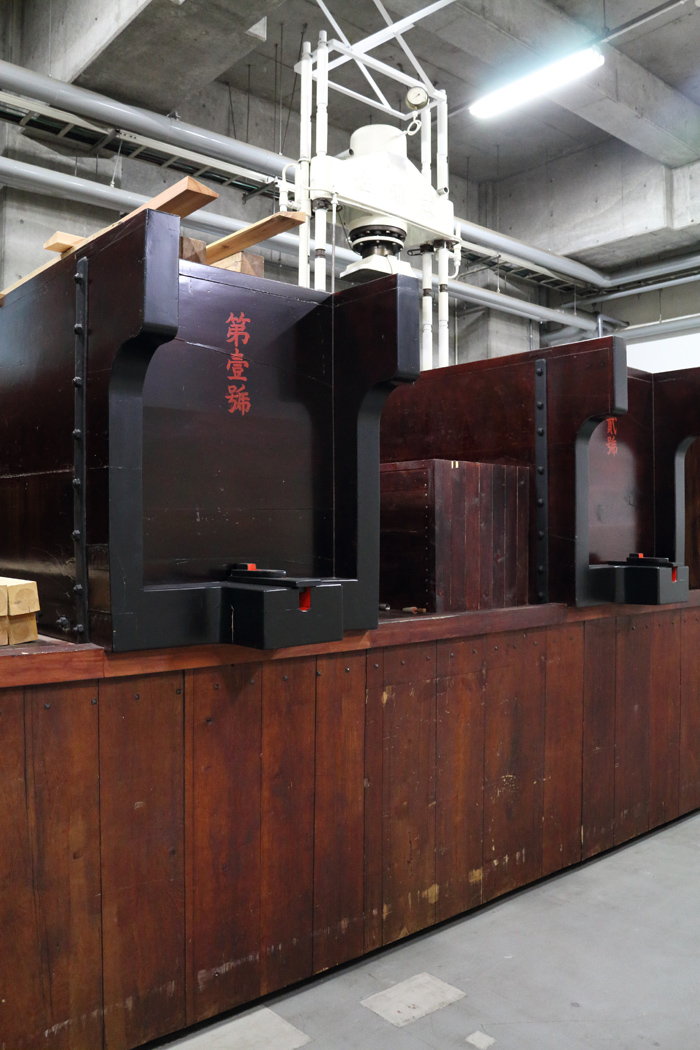
Wooden box presses, known as “kibune” in the Daishichi brewery. A method of separating the completed sake from the fermented rice solids that leads to extravagant sake.
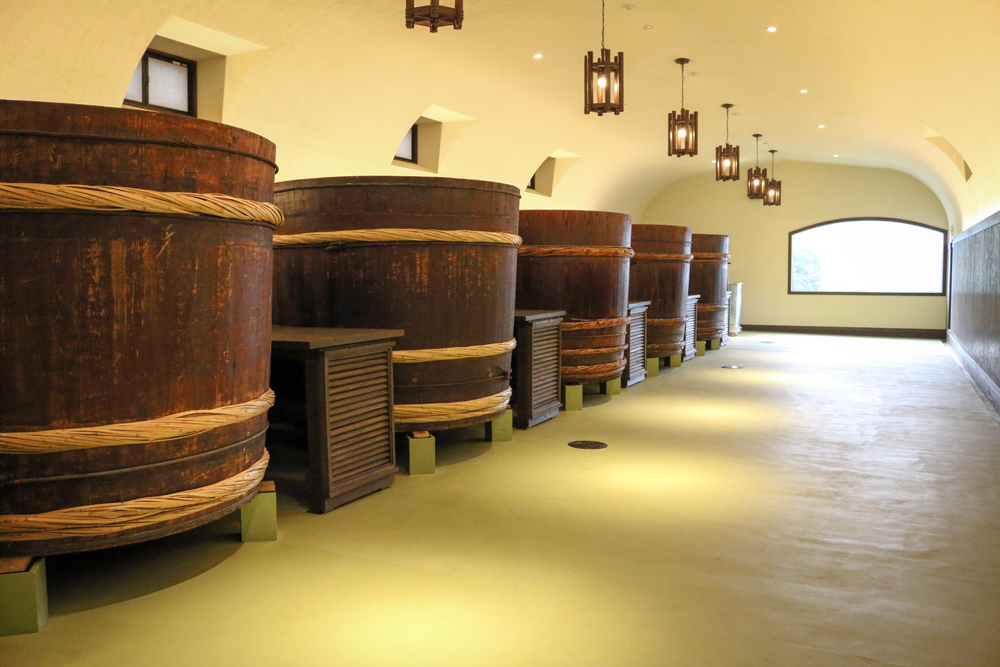
Wooden tanks like these, known as “ki-oke,” were the norm until the 1940s. Daishichi makes several batches a year in these traditional fermentation tanks.
Nor does it have to be to create great sake. Daishichi has evolved and excelled because it recognizes what it can borrow from both past and present to greatest effect. Its bottling practice is another great example. The bottling line is one of the most advanced in Japan and also the first anoxic system. The machine first removes air from the bottle to create a vacuum, then fills it with nitrogen. Sake is added next and the bottle is sealed. Ohta wants to prevent oxidization of the sake, but not completely. Due to trace amounts of oxygen, the sake matures with time.
Ohta opens the door to the aging room and continues walking down the central row of several rows in the room. Shelves that reach the ceiling on both sides support bottles of Daishichi’s finished products. When Ohta reaches the end of the room, he opens another door that reveals another identical room. And then another. It’s like a house of mirrors, but in somebody’s sake heaven. The final production stop for some of Daishichi’s best sake, which has already taken significantly extra time to make, is a shelf of time–in some cases, several years.
Ohta’s family and brewery have endured the many whims and disasters of both history and Mother Nature to survive into the present. WWII and its immediate aftermath was just one of many existential threats. Old traditions died in those bleak years before and after 1945, and with post-war prosperity, many brewers embraced newer methods of production. Daishichi continued brewing kimoto and has been largely responsible for its renaissance.
A long family history has provided Ohta perspective. He can see that time–we might even say patience–often yields favorable results. Slow is good. Old is better. And if it isn’t, be as nimble and new as possible.
Family legacy is just an opportunity and people squander that all the time. Ohta had to see and believe that kimoto would continue to work in this age of globalization and diverse tastes. He gives every impression that his decision to continue brewing Old School kimoto was not due to stubbornness, but to vision. Without that, he would not have adopted advantages of the present day, from state-of-the art bottling to exquisitely beautiful label design, all of which continue to elevate his company to new heights. Without that, “kimoto” might have been another footnote in history.
by Ry Beville

